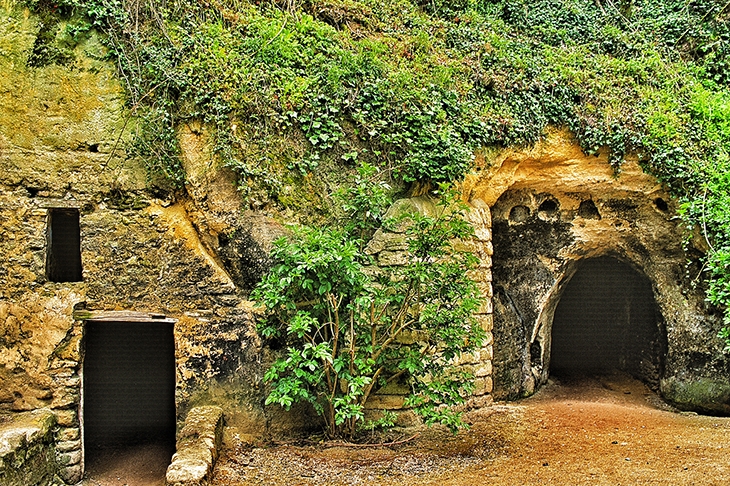This Provençal village clusters around the base of a cliff 300 feet high and a kilometre wide surmounted by two crumbling look-out towers. The cliff is riddled with dry caves, used since time immemorial by troglodytes and fugitives. In the early 19th century a section of the rock face was walled and the caves used as a convalescent hospital for Napoleon’s wounded soldiers. An earth tremor largely destroyed the village’s medieval quartier in 1905. The stoutly built military hospice survived, as well as a few other ancient cave dwellings higher up the cliff.
Catriona and I live in one of these. House and garden sit on a high ledge accessible via a steep and rocky footpath. In normal times tourists pay €2 a head to visit the Napoleonic hospice, the old village ruins, and a sorry-looking reconstruction of a humble peasant interior of 100 years ago, consisting of a few sticks of old furniture and a collection of outmoded kitchen utensils displayed behind bars. Fitter and more intrepid visitors wishing to get their full €2-worth of local history explore the cliff path that leads them up finally to our dusty perch. Those peering in at the lowest window, half-expecting to see another reconstructed peasant interior, usually see instead your Low Life correspondent lying unshaven in bed looking at his iPad.
He contemplated the disparate items I had placed on the table: typewriter, Roberts radio, breast reduction tablets
An unexpected benefit of France’s stringent social-distancing measures has been that this intrusive trickle of Gore-tex-wearing, camera-wielding sightseers has dried up and we are presently enjoying splendid isolation among the ravens. Each morning I can now sit with impunity in my pyjamas in the garden. I sit at a round metal table in a small, embowered, gravel-floored space just off the footpath, drinking coffee, listening to the radio and typing my journal of a plague year on a 1965 Hermes typewriter.
Immediately behind me is bare rock face fantastically contoured by a vanished waterfall. To my right is a tin-roofed log store. A hobbit-like door in the rock leads to a spare one-bed cave apartment with stalactites in the lavatory. To my left is a mimosa tree, an oleander bush, a mulberry tree, a tropical palm and a monster aloe. Above the woodshed, and surrounding the hobbit door, the yellow blooms of a climbing banksia are out in profusion.
The merchant seaman who restored the house in the 1960s had an artistic bent. He vented his creative impulse by nailing unlikely or incongruous objects to the wall around the hobbit door: a gin trap, a toy car, a bird cage with a clock inside, a sheep’s skull, a horseshoe, a wooden duck, an enormous key. When he wasn’t at sea, the meticulous restoration of his cave house was his life’s work and we’ve kept these gnarled and tatty things on the wall in honour of his salty, eccentric spirit.
The day before yesterday I was sitting at the table in my jim-jams, radio on, typing. Crunching gravel suggested that Catriona was coming to join me for morning coffee. But instead of a small Scottish woman, a tall rangy Dutchman appeared and stood benignly contemplating me from a distance of about three yards. I knew he was Dutch because he told me so straight away. Speaking in pigeon French and gesturing theatrically at the bare rock face, he said, ‘France, she have big rocks. But my country Holland is very flat.’ To emphasise the superior flatness of the Netherlands he made a long slow sweeping gesture with his hand, as though lovingly smoothing the baize on a billiard table. ‘Yes. I know,’ I said, in English. The English reply wasn’t enough, however, to deflect this man’s fixed idea that I and my admittedly quaint surroundings were a living historical tableau arranged, maintained and subsidised by the town council. And that, fortunately for him, nobody had told me to stop working.
Hands clasped behind his back, a half-smile of intelligent interest on his face — that complacent smile of the living for the curated artefacts of the dead — he stepped confidently into my bower and scrutinised me, the table and the disparate items I had arranged on it: coffee pot, mug, antique spoon, typewriter, Roberts radio, breast-reduction tablets. Then he came and stood behind me and leant over my shoulder, either to read what I’d typed or to ascertain whether or not I was acting. Then he turned and looked with absorbed fascination at the logs in the woodshed, at the gin trap nailed to the wall, at the vine-wreathed satyr head on a spike, at the hobbit door in the rock (shut and locked fortunately). He concluded his visit with a leisurely circuit of the garden. When he passed me again on his way out, I had resumed typing. ‘Très très bon,’ he said. Taking this as a history connoisseur’s praise for a hidden gem, I gravely inclined my head.







Comments